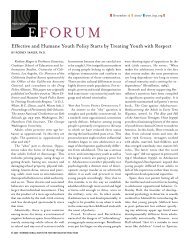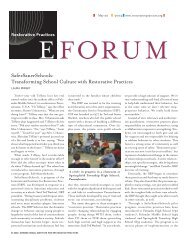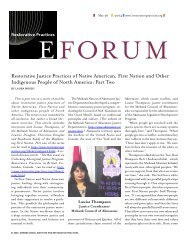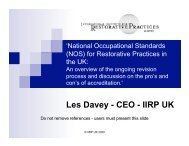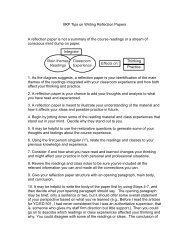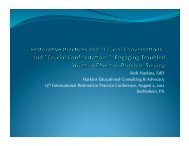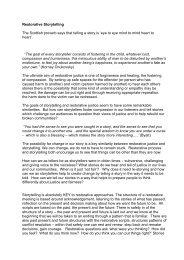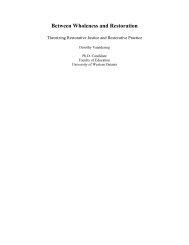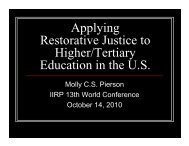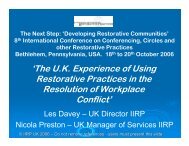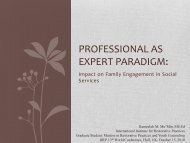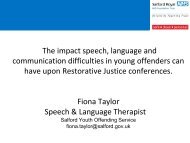Modeling RJ City SM : Lessons Learned - IIRP
Modeling RJ City SM : Lessons Learned - IIRP
Modeling RJ City SM : Lessons Learned - IIRP
You also want an ePaper? Increase the reach of your titles
YUMPU automatically turns print PDFs into web optimized ePapers that Google loves.
the area, which has driven up the cost of living. The tension between the university<br />
community and the local community has a long and established pattern that divides<br />
people predominantly along racial lines. And while money is spent on providing for<br />
better-than-average state allotments for public school students, the academic success of<br />
minority students does not reflect well for a place that values education. Poverty and<br />
race have been intertwined for generations throughout the state but it is magnified in our<br />
area. Albemarle County has 54% fewer individuals living in poverty than the national<br />
average, while Charlottesville <strong>City</strong> (where the university is located) has 30% more<br />
individuals living in poverty than the national average – even when the student<br />
population is factored out of the figures. There have been budget increases (averaged<br />
for the two municipalities) between 1997 and 2005 of 823% for the regional jail, 422% for<br />
the juvenile detention center, and only 60% for schools. As our community is waking up<br />
to circumstances that generations of people have tried to educate us about only to be<br />
summarily ignored or thought worse of, we must face the fact that we have failed to<br />
protect the integrity of a large measure of our citizens and their families at great cost to<br />
us all.<br />
Current recommendations:<br />
Work with schools, youth programs, and their families to strengthen their understanding<br />
of restorative practices when addressing behaviors so that we can improve academic<br />
commitment and success.<br />
Complete the organization and establishment of the Abundant Life Program’s efforts with<br />
ample and secured funding so that community has access to restorative practices,<br />
conferencing, training and a coordinator for victim’s needs. Then use the success of this<br />
project to set up similar services to areas designated by the Quality Community Council.<br />
Expand the services currently being offered through Central Virginia Restorative Justice,<br />
a program attached to the Juvenile and Domestic Court<br />
Support the reorganization of the Charlottesville Mediation Center and help find funding<br />
for more preventative or non-court programs at a sliding scale cost to citizens.<br />
Continue the community discussion and consensus phase as laid out in the<br />
organizations plan of action and ‘A Restorative Community would likely have…’<br />
(attachments 1 and 2).<br />
Continue to serve on Task Forces, Study Groups and organizations representative of<br />
restorative practices.<br />
<strong>RJ</strong> <strong>City</strong> Step 1: Community Discussion and Consensus<br />
Tipping Point – Are We There Yet? Or What Seems to be Working?<br />
Use Public Access TV (non-commercial) to run available high-quality documentary<br />
programs with permission. <strong>IIRP</strong> has an excellent selection.<br />
Collect and write news articles particularly when an opportunity arises to shape<br />
discussions. Several of us scan news regularly from public and professional writings,<br />
share the articles, and save them for reference. Additionally, we collect 1-2 paragraph<br />
statements with data for talking points necessary for short presentations of material.



